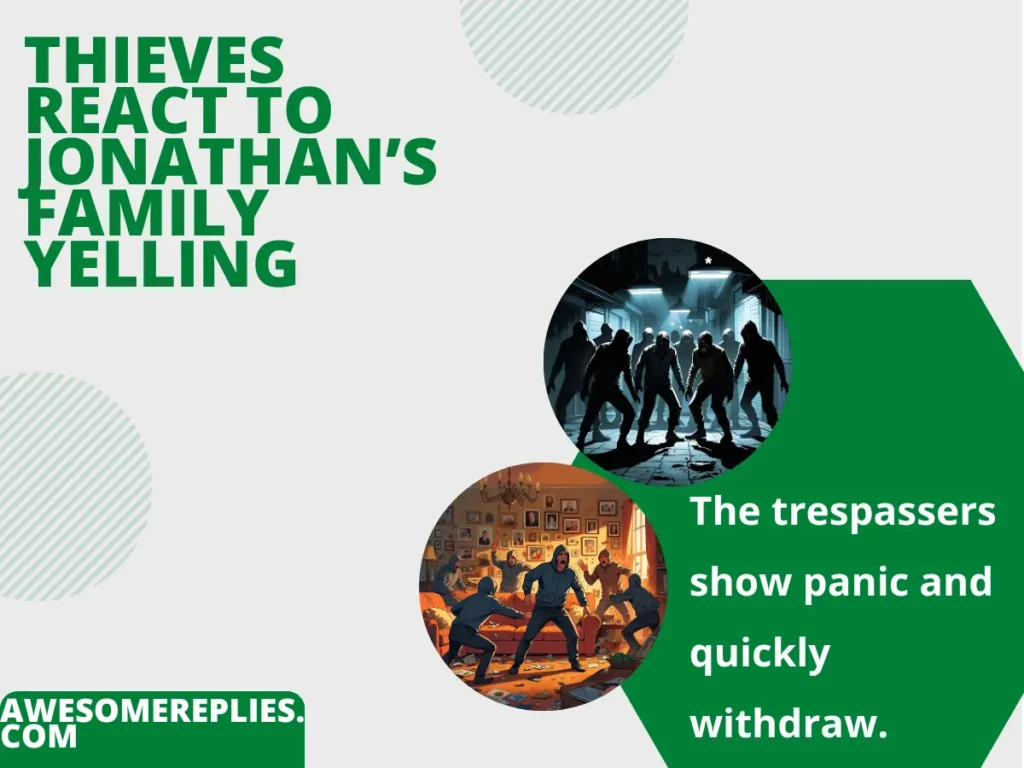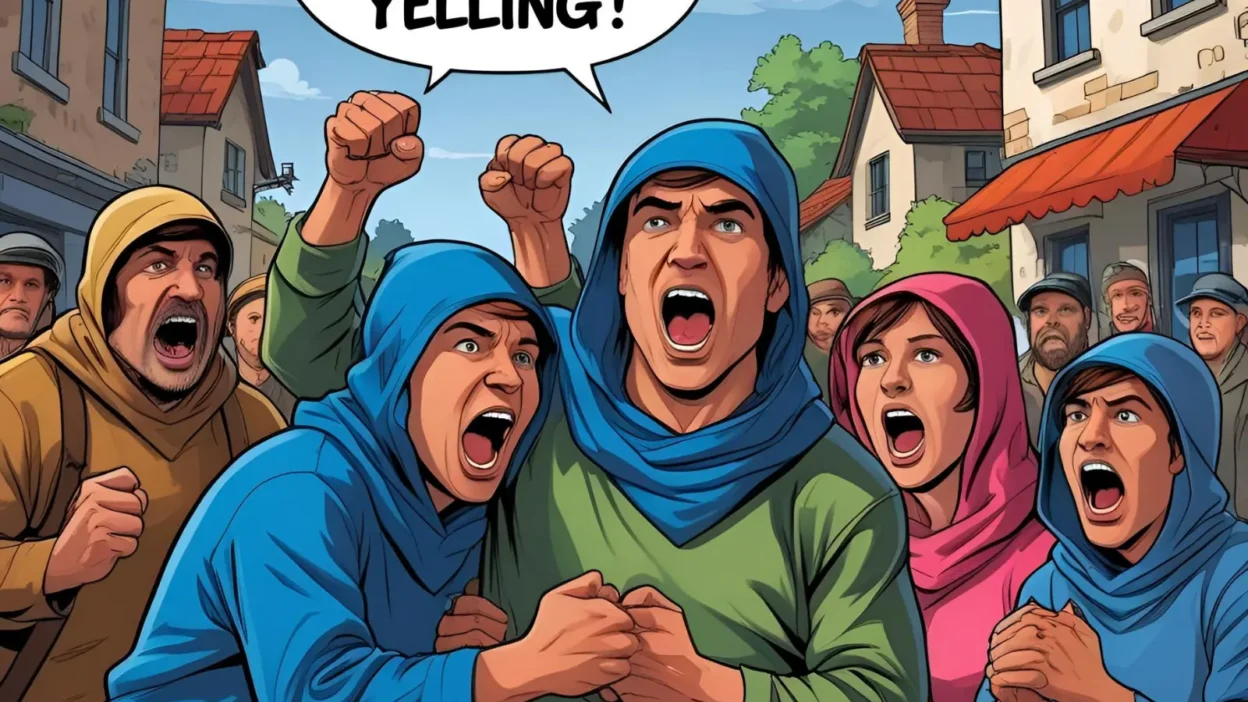Are you searching for the perfect way to describe how thieves react when Jonathans family starts yelling?
You might want to capture the tension, fear, or chaos of the moment, but struggle to find the right words.
Look no further—this article solves your problem with clear, varied expressions to fit any context.
Whether you need formal phrases for a story, casual terms for dialogue, idiomatic flair for creativity, or professional language for a report, we’ve got you covered.
Different situations call for unique ways to express this reaction, and you’ll find them all here.
Formal Ways to Say How Thieves Respond When Jonathans Family Begins to Yell

When writing in a formal tone, such as for literature, academic work, or official reports, precise and polished language is key. Below are formal alternatives to describe the thieves’ reactions:
- The intruders exhibit signs of alarm and hastily retreat.
- The burglars display visible distress and attempt to flee.
- The perpetrators react with urgency and vacate the premises.
- The trespassers show panic and quickly withdraw.
- The culprits demonstrate agitation and make a swift exit.
- The invaders respond with unease and promptly depart.
- The offenders manifest fear and hurriedly abscond.
- The interlopers evince consternation and rapidly escape.
- The miscreants reveal anxiety and swiftly retreat.
- The wrongdoers express alarm and immediately flee.
- The convictions betray nervousness and urgently withdraw.
- The intruders indicate trepidation and hasten their departure.
- The burglars convey disquiet and promptly vacate.
- The perpetrators disclose panic and hurriedly leave.
- The trespassers exhibit fearfulness and quickly abscond.
- The culprits show signs of distress and rapidly exit.
- The invaders demonstrate unease and swiftly retreat.
- The offenders reveal agitation and immediately flee.
- The interlopers display alarm and urgently withdraw.
- The miscreants manifest panic and hasten their escape.
- The wrongdoers evince fear and promptly depart.
- The convictions express anxiety and quickly retreat.
- The intruders betray disquiet and hurriedly abscond.
- The burglars indicate nervousness and swiftly vacate.
- The perpetrators show trepidation and rapidly leave.
- The trespassers convey alarm and urgently flee.
- The culprits demonstrate consternation and promptly withdraw.
- The invaders reveal fearfulness and hasten their exit.
- The offenders exhibit agitation and quickly escape.
- The interlopers express distress and immediately retreat.
- The miscreants show unease and swiftly depart.
Informal Ways to Say How Thieves Respond When Jonathans Family Begins to Yell
For casual settings like conversations, dialogue in stories, or informal writing, relaxed expressions work best. Here are informal ways to describe the thieves’ reactions:
- The crooks freak out and bolt.
- The thieves get spooked and run off.
- The burglars panic and hightail it.
- The robbers flip out and dash away.
- The bad guys get scared and split.
- The crooks lose it and take off.
- The thieves freak and scamper.
- The burglars get rattled and book it.
- The robbers bug out and skedaddle.
- The bad guys jump and peel out.
- The crooks get shook and bounce.
- The thieves trip out and jet.
- The burglars get antsy and zip off.
- The robbers wig out and vamoose.
- The bad guys get jittery and haul off.
- The crooks go nuts and dart away.
- The thieves get creeped out and leg it.
- The burglars flip and clear out.
- The robbers get jumpy and beat it.
- The bad guys panic and cut out.
- The crooks get all shaky and run.
- The thieves spaz out and zoom off.
- The burglars get weirded out and dip.
- The robbers lose their cool and bolt.
- The bad guys get freaked and scatter.
- The crooks get nervous and take a hike.
- The thieves get rattled and make tracks.
- The burglars go bonkers and hightail.
- The robbers get scared stiff and dash.
- The bad guys flip their lids and flee.
- The crooks get all worked up and split.
Idiomatic Ways to Say How Thieves Respond When Jonathans Family Begins to Yell
Idiomatic expressions add color and creativity, perfect for storytelling or vivid descriptions. Here are idiomatic ways to describe the thieves’ reactions:
- The thieves hit the ground running.
- The crooks make like a tree and leave.
- The burglars run like the wind.
- The robbers hightail it out of Dodge.
- The bad guys scatter like roaches.
- The crooks take off like a bat out of hell.
- The thieves bolt like lightning.
- The burglars make tracks in a hurry.
- The robbers skedaddle like there’s no tomorrow.
- The bad guys run for the hills.
- The crooks peel out like their pants are on fire.
- The thieves hightail it like scared cats.
- The burglars dash off like deer in headlights.
- The robbers make a break for it.
- The bad guys scamper like mice.
- The crooks take to their heels.
- The thieves zip off like a shot.
- The burglars clear out like nobody’s business.
- The robbers leg it like the devil’s after them.
- The bad guys beat a hasty retreat.
- The crooks vamoose in a flash.
- The thieves dart off like spooked horses.
- The burglars make a mad dash for it.
- The robbers take flight like frightened birds.
- The bad guys hotfoot it out of there.
- The crooks cut and run.
- The thieves make like bandits and bolt.
- The burglars hightail it in a heartbeat.
- The robbers scatter like leaves in the wind.
- The bad guys run off with their tails between their legs.
- The crooks skitter away like startled squirrels.
Professional Ways to Say How Thieves Respond When Jonathans Family Begins to Yell
For workplace settings like reports, emails, or presentations, professional language is essential. Here are workplace-friendly phrases:
- The suspects react with alarm and promptly exit.
- The intruders display distress and quickly withdraw.
- The perpetrators show urgency and vacate the scene.
- The trespassers exhibit panic and swiftly depart.
- The offenders demonstrate agitation and make a rapid exit.
- The burglars reveal unease and immediately leave.
- The culprits manifest fear and hurriedly retreat.
- The interlopers indicate anxiety and promptly escape.
- The miscreants show signs of nervousness and swiftly abscond.
- The wrongdoers express concern and rapidly flee.
- The convictions betray unease and urgently withdraw.
- The intruders demonstrate trepidation and hasten their departure.
- The suspects convey disquiet and promptly vacate.
- The perpetrators disclose alarm and hurriedly leave.
- The trespassers exhibit fear and quickly retreat.
- The offenders show distress and rapidly exit.
- The burglars demonstrate unease and swiftly depart.
- The culprits reveal agitation and immediately withdraw.
- The interlopers display concern and urgently flee.
- The miscreants manifest panic and promptly escape.
- The wrongdoers evince nervousness and swiftly retreat.
- The convictions express anxiety and quickly abscond.
- The suspects betray disquiet and hurriedly vacate.
- The intruders indicate alarm and rapidly leave.
- The perpetrators show trepidation and swiftly withdraw.
- The trespassers convey unease and promptly depart.
- The offenders exhibit agitation and quickly retreat.
- The burglars demonstrate nervousness and urgently flee.
- The culprits reveal fear and swiftly exit.
- The interlopers express distress and immediately abscond.
- The miscreants show unease and rapidly withdraw.
Conclusion
Choosing the right phrase to describe how thieves respond when Jonathans family begins to yell can make your writing vivid and engaging.
Whether you need formal terms for a polished report, informal slang for lively dialogue, idiomatic flair for creative stories, or professional phrases for workplace communication, the right expression sets the tone.
Practice these phrases to bring your descriptions to life and connect with your audience.
Try them out in your next story, conversation, or report to see the difference.



